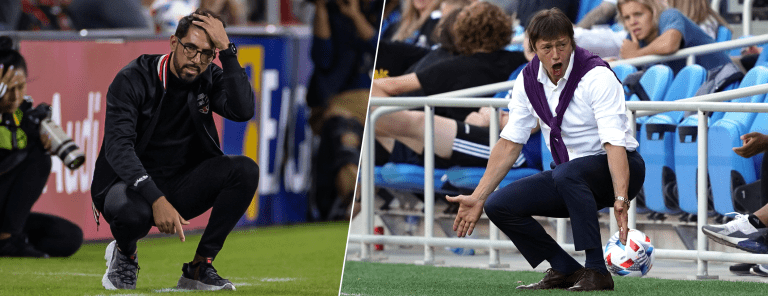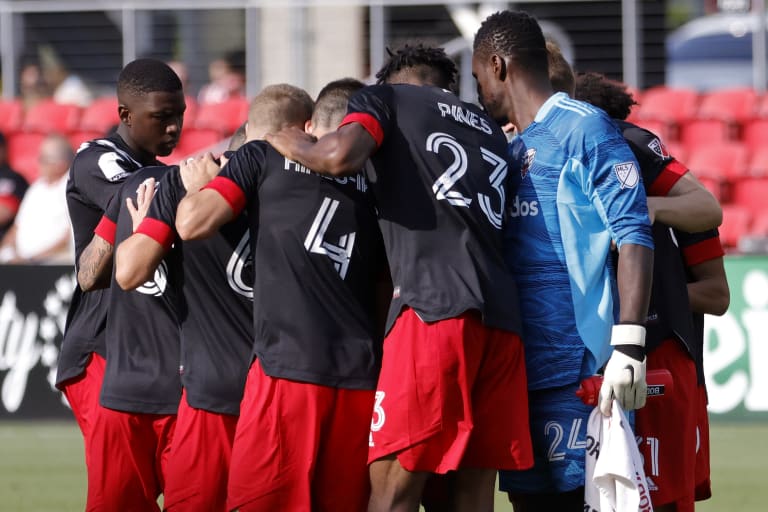The demand for results around MLS is increasing. Just ask Hernan Losada and Matias Almeyda after D.C. United and the San Jose Earthquakes respectively made coaching changes this week.
In my experience, these moments of change are never easy for anyone, but things can get back on track with the right approach. Both clubs can still salvage their 2022 season, given there's ample time and a summer transfer window approaching to make some vital moves that could reinvigorate and reestablish belief in their squads.
How, you might ask? Let’s take a closer look at what’s unfolding.
Experiencing a coaching change
I had my first coaching change when I was playing in France. I was loaned out to D.C. United for the 2011 season, and when I returned the coach who had brought me in had resigned and left to manage Bordeaux.
The manager who was brought in to replace Francis Gillot was former FC Sochaux player and Bosnian international star Mehmed Bazdarevic. He welcomed me back to the club when my loan expired and told me after I trained with the club for a month to regain my match fitness and prove I was ready, he would give me my chance. He proved to be honest when I was subbed in a month later, my first match since September 2009, playing away against Rennes. I was very grateful that he gave me the opportunity to play again.
I noticed that the players were frustrated with the training sessions, that they disagreed with his tactics. My closest teammate would translate for me, mentioning that there were no instructions on how the team would attack or defend. The players were unsettled and the toxicity grew. After eight months in charge, Bazdarevic was sacked and the team found itself sitting in last place in the 20-team Ligue 1 table.
We were winless in 13 games and in need of a different approach. For the first time, I found myself in a situation where a coaching change occurred during the season and the push was on to maintain top-flight status, considering we were below the relegation line.
The club promoted from within and hired academy coach Eric Hely. He quickly resorted to a formation that suited our young group of players when he coached them as youths. He played the players he was very familiar with, having built strong relationships with them through the years. That meant the end of my playing time with the club, as I was permanently resigned to the reserves. The first-team players responded to the new manager with results. We won two straight matches and we ultimately took home three points in four of the first six matches Hely was in charge.
The fun had returned to training; he would frequently joke with the players to lighten the mood. Players clearly enjoyed coming to training and felt that he would listen to the senior players on what needed to be done to get everything turned around. Hely took nine points from the last three matches to finish 14th place in Ligue 1, four points above the relegated Caen.
The team all got behind Hely. The belief in the system and in each other allowed our squad to get the necessary points to stay above the drop. What I saw was a unit working together to thrive. The cohesion both defensively and in the attack separated us from the bottom of the pack. However, without long-term planning, Hely was relieved from his duties and Sochaux were eventually relegated in 2013-14.
New-coach bump?
When D.C. United’s Hernan Losada was sacked for his poor start to the season, players talked about how interim head coach Chad Ashton has brought the fun back to the dressing room and training already. Lifting the team morale is typically the first and most effective action taken by the interim manager to get players motivated again.
I played under Ashton while he was an assistant coach for D.C. United in 2011. He’s good at communicating with players and trying to motivate them and keep them thinking in a positive manner. He’s the type of coach that uses his influence to have his players playing with the maximum intensity to outwork teams if things aren’t necessarily there tactically and technically.
At this stage, D.C. United need to get back to a more regulated training environment to bring back the energy for matchdays on the weekend. It seems that Losada never allowed his team to recover because he was so focused on pushing the limits of their maximum fitness and their workload capacity. It took a toll on their psyche, which often causes players to lose the passion and joy to train and be in that environment.
It's also not like Ashton is walking into a barren roster. Guys like goalkeeper Bill Hamid and defender Julian Gressel are proven MLS veterans, and there's some exciting homegrown talent with the likes of midfielder Moses Nyeman and attacker Griffin Yow. Up top, the Black-and-Red invested in Taxi Fountas, Michael Estrada and Edison Flores for a reason – the talent is there to set things right.

As for Almeyda, he did not implement a consistent formation or style of play that would bring success in San Jose. There were too many up-and-down performances where the results would mimic a roller coaster. Look no further than early in the 2019 season, when the Quakes lost 5-0 to LAFC and won the following week 3-0 to Portland. These swings became normal due to the erratic style Almeyda went with. In that situation, it is easy to lose confidence in the coach and his philosophy. Almeyda would also mention that the club did not give him the resources to invest the way he wanted in the team. Comments like that make their way to the press and can unsettle a locker room.
For me, San Jose can still turn this season around under interim boss Alex Covelo, promoted from their MLS NEXT Pro team and carrying prior work in the academy. You are never really out of the race at this stage in the season.
Covelo needs to bring stability to the team and build a defensive foundation. The strength of this team is the collective. Utilize the quality in the team by allowing Cade Cowell and Cristian Espinoza to expose teams on the counter, then have Jeremy Ebobisse as the No. 9. The midfield trio of Jamiro Monteiro, Jackson Yueill and Jan Gregus can form a formidable partnership if the balance is right while the intensity to defend and win second balls is the priority. On his day, Francisco Calvo is an effective center back in the attack (breaking lines with his passing ability, and a real threat to get on the end of attacking set pieces). When partnered with a calm, reserved center back (Nathan or Tanner Beason, perhaps?) he can excel.
For both clubs, strong pieces are on the roster. Now it's about putting them in positions to succeed and bolstering in the summer window.
Value the locker room
In 2016, I had come into the season with the highest of expectations after scoring 10 league goals for the New England Revolution. I put the pressure on myself to make one final push for a shot at getting a call-up to the USMNT. However, that was not to be. My wife had given birth to our twin boys, now 6 years old, three months early. They had been in the Neonatal Intensive Care Unit for 92 days in total.
The injuries came thick and fast for me during that time, which led to the discovery of a cancerous liposarcoma tumor. I had extensive surgery to remove the tumor and returned to the pitch two months later. The locker room supported me throughout and they continuously lifted my spirits. The season hadn’t gone according to plan for the squad but there was a quiet confidence that we could turn it around and make a run in the playoffs.
I was traded the following week after playing in my first official match since the diagnosis. New England’s form quickly took a dip. The trade took a player that was central to the squad’s culture out of the picture. When general managers or coaches make the wrong decision in terms of signing a player or moving a player, it can spell the end of a coach's term. The Revs did not make the playoffs that season and the coach, Jay Heaps, was removed from his duties in 2017.
The culture piece is sometimes lost when building a team. Locker room guys are the glue and can also keep things from getting toxic. They are the players the coaching staff can bounce ideas off of, as well as get a sense of what the players need in terms of competing at a high level. It’s important when forming a team to incorporate these types of players, just as you would a DP striker.
Did Almeyda and Losada lose sight of that? Perhaps, especially as negative results piled up. Is it something that Ashton and Covelo must keep in mind? Most certainly.

The path forward
I love that across the league there are greater demands and expectations placed on the coaches to get results. In the years past, clubs would allow some coaches to have subpar results, year after year, without much consequence or pressure. While I do believe it is vital to believe and have confidence in a new coach, and give them that necessary time to build their team and see their plan come to life, there comes a point when it's obvious that progress is not being made, and they have to be held accountable.
In Almeyda’s situation at San Jose, he was given time (three-plus seasons) and resources to bring in players to change the outlook of the Earthquakes. His philosophy and system did not meet expectations. In the end, the players he brought in did not make the impact he was hoping for. The writing was on the wall.
For Losada, he was not given the same amount of time (15 months) to see out his plan because his approach alienated the locker room. There wasn't a balance with his philosophy. As much as he pushed his team over the line, he didn't provide them with rest, recovery and flexibility. That creates turmoil.
Now, are these the only situations we’ll be talking about in the 2022 MLS season? Probably not, if last year’s nine changes are any indication. But keep the above dynamics in mind, just how fragile they are for coaches and players alike.
It is a results-oriented business, after all.










